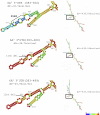Human SP-A1 (SFTPA1) variant-specific 3' UTRs and poly(A) tail differentially affect the in vitro translation of a reporter gene
- PMID: 20693318
- PMCID: PMC2957414
- DOI: 10.1152/ajplung.00113.2010
Human SP-A1 (SFTPA1) variant-specific 3' UTRs and poly(A) tail differentially affect the in vitro translation of a reporter gene
Abstract
Human surfactant protein A (SP-A) is encoded by two functional genes (SFTPA1, SFTPA2) with a high degree of sequence identity. Sequence differences among these genes and their genetic variants have been observed at the 5' and 3' untranslated regions (UTRs). In this work, we studied the impact on translation of the SFTPA1 (hSP-A1) and SFTPA2 (hSP-A2) gene 5' UTR splice variants and 3' UTR sequence variants, in the presence or absence of poly(A) tail. We generated constructs containing the luciferase reporter gene flanked upstream by one of the hSP-A 5' UTR splice variants and/or downstream by one hSP-A 3' UTR sequence variant. mRNA transcripts were prepared by in vitro transcription and used for either in vitro translation with a rabbit reticulocyte lysate or transient transfection of the lung adenocarcinoma cell line NCI-H441. The luciferase activity results indicate that hSP-A 5' UTR and 3' UTR together have an additive effect on translation. In this context, the hSP-A1 6A(3) and 6A(4) 3' UTR variants exhibited higher translation efficiency than the 6A(2) variant (P <0.05), whereas no significant difference was observed between the two hSP-A2 3' UTRs studied (1A(0), 1A(3)). Further sequence analysis revealed that a deletion of an 11-nucleotide (nt) element in both the 6A(3) and 6A(4) 3' UTR variants changes the predicted secondary structure stability and the number of putative miRNA binding sites. Removal of this 11-nt element in the 6A(2) 3' UTR resulted in increased translation, and the opposite effect was observed when the 11-nt element was cloned in a guest 3' UTR (6A(3), 6A(4)). These results indicate that sequence differences among hSP-A gene variants may account for differential regulation at the translational level.
Figures









Similar articles
-
Genetic complexity of the human surfactant-associated proteins SP-A1 and SP-A2.Gene. 2013 Dec 1;531(2):126-32. doi: 10.1016/j.gene.2012.09.111. Epub 2012 Oct 12. Gene. 2013. PMID: 23069847 Free PMC article. Review.
-
An 11-nt sequence polymorphism at the 3'UTR of human SFTPA1 and SFTPA2 gene variants differentially affect gene expression levels and miRNA regulation in cell culture.Am J Physiol Lung Cell Mol Physiol. 2014 Jul 1;307(1):L106-19. doi: 10.1152/ajplung.00313.2013. Epub 2014 May 2. Am J Physiol Lung Cell Mol Physiol. 2014. PMID: 24793167 Free PMC article.
-
Differences in the translation efficiency and mRNA stability mediated by 5'-UTR splice variants of human SP-A1 and SP-A2 genes.Am J Physiol Lung Cell Mol Physiol. 2005 Sep;289(3):L497-508. doi: 10.1152/ajplung.00100.2005. Epub 2005 May 13. Am J Physiol Lung Cell Mol Physiol. 2005. PMID: 15894557
-
The untranslated exon B of human surfactant protein A2 mRNAs is an enhancer for transcription and translation.Am J Physiol Lung Cell Mol Physiol. 2011 Nov;301(5):L795-803. doi: 10.1152/ajplung.00439.2010. Epub 2011 Aug 12. Am J Physiol Lung Cell Mol Physiol. 2011. PMID: 21840962 Free PMC article.
-
Differential Regulation of Human Surfactant Protein A Genes, SFTPA1 and SFTPA2, and Their Corresponding Variants.Front Immunol. 2021 Nov 30;12:766719. doi: 10.3389/fimmu.2021.766719. eCollection 2021. Front Immunol. 2021. PMID: 34917085 Free PMC article. Review.
Cited by
-
Genetic complexity of the human surfactant-associated proteins SP-A1 and SP-A2.Gene. 2013 Dec 1;531(2):126-32. doi: 10.1016/j.gene.2012.09.111. Epub 2012 Oct 12. Gene. 2013. PMID: 23069847 Free PMC article. Review.
-
Air pollution and epigenetics: effects on SP-A and innate host defence in the lung.Swiss Med Wkly. 2012 May 2;142:w13579. doi: 10.4414/smw.2012.13579. eCollection 2012. Swiss Med Wkly. 2012. PMID: 22553125 Free PMC article. Review.
-
Surfactant protein genetics in community-acquired pneumonia: balancing the host inflammatory state.Crit Care. 2011;15(2):156. doi: 10.1186/cc10115. Epub 2011 Apr 21. Crit Care. 2011. PMID: 21575284 Free PMC article.
-
Knockdown of Drosha in human alveolar type II cells alters expression of SP-A in culture: a pilot study.Exp Lung Res. 2014 Sep;40(7):354-66. doi: 10.3109/01902148.2014.929757. Epub 2014 Jul 24. Exp Lung Res. 2014. PMID: 25058539 Free PMC article.
-
Exon B of human surfactant protein A2 mRNA, alone or within its surrounding sequences, interacts with 14-3-3; role of cis-elements and secondary structure.Am J Physiol Lung Cell Mol Physiol. 2013 Jun 1;304(11):L722-35. doi: 10.1152/ajplung.00324.2012. Epub 2013 Mar 22. Am J Physiol Lung Cell Mol Physiol. 2013. PMID: 23525782 Free PMC article.
References
-
- Alexiou P, Maragkakis M, Papadopoulos G, Reczko M, Hatzigeorgiou A. Lost in translation: an assessment and perspective for computational microRNA target identification. Bioinformatics 25: 3049–3055, 2009 - PubMed
-
- Andreassi C, Riccio A. To localize or not to localize: mRNA fate is in 3′UTR ends. Trends Cell Biol 19: 465–474, 2009 - PubMed
-
- Boggaram V, Mendelson C. Transcriptional regulation of the gene encoding the major surfactant protein (SP-A) in rabbit fetal lung. J Biol Chem 263: 19060–19065, 1988 - PubMed
-
- Boggaram V, Smith M, Mendelson C. Posttranscriptional regulation of surfactant protein-A messenger RNA in human fetal lung in vitro by glucocorticoids. Mol Endocrinol 5: 414–423, 1991 - PubMed
-
- Bruns G, Stroh H, Veldman G, Latt S, Floros J. The 35 kd pulmonary surfactant-associated protein is encoded on chromosome 10. Hum Genet 76: 58–62, 1987 - PubMed
Publication types
MeSH terms
Substances
Grants and funding
LinkOut - more resources
Full Text Sources
Molecular Biology Databases
Research Materials
Miscellaneous

